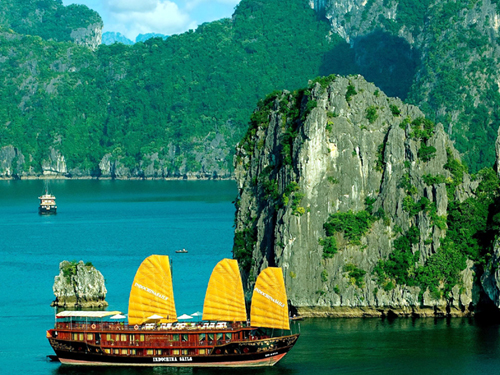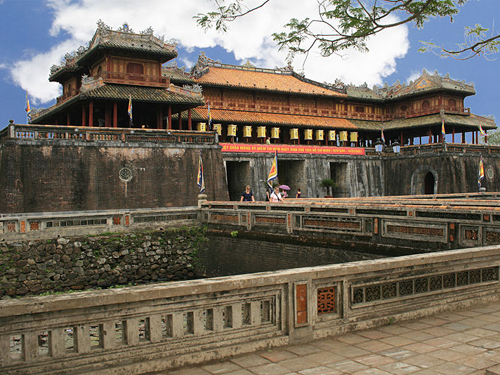If Hanoi is the grand old dame of Vietnam and Ho Chi Minh City is the brash young floozy, then Halong Bay, Hue and Hoi An are the alluring mistresses you encounter along the way. Here landscape, architecture, culture and cuisine work their seduction via subtle charms rather than sensory overload.
The first stop on our north-south journey from Hanoi to Ho Chi Minh City was a side trip to the unchanging wonders of Halong Bay, where thousands of limestone outcrops rear from the placid aquamarine waters of the Gulf of Tonkin.
The voyage, on a luxury sleep-aboard wooden junk, was an immediate immersion in oriental serenity as we glided calmly through the narrow channels past floating fishing villages where life is lived on the water as it has been for centuries.
After the vessel anchored under a moonlit sky, we dined against a spectacular backdrop of pinnacles and towers that, by sunrise, seemed to have morphed into strange sea monsters emerging from the mist.
These islands are pitted with caves and chambers and the morning hike to the Grotto of the Heavenly Palace was rewarded with a stunning display of stalactites and stalagmites.
We then flew south to the country’s geographic and spiritual heart, Hue, the imperial capital from 1802 to 1945. And from its perch overlooking the Perfume River, the Art Deco comfort of La Résidence – the elegant former French colonial governor’s home-turned-hotel – provided a majestic base for exploration.
That evening we dined out in style on the local specialty: banh khoai (a crispy pancake of shrimp, pork and bean sprouts) with nuoc leo (a peanut sauce), bun bo (spicy beef noodle soup) and seafood with vegetables.
Food in Hue is served with formality and elegance, with a tradition of “royal cuisine” where as much emphasis is placed on the aesthetics of a dish’s colors and presentation as its contents and cooking. It certainly made for a formidable treat for the eyes as well as the taste buds.
The next day we struck out for the elaborate royal mausoleums that the emperors built for themselves among the low hills south of town. Our reward for toiling through the heat on bicycles was some glorious snapshots of rural life – as well as the final imperial resting places themselves.
The bustling modernity of Danang holds little interest unless you want to see close up how wholeheartedly the country’s rulers have marched from Marx to Mammon. But we were heading for the slow-paced charms and architectural heritage of Hoi An, a 30-minute drive south that took us past the shimmering white sand expanse of China Beach, where luxury all-inclusive resorts and golf courses are now springing up with alacrity.
While Hue still carries the aloofness of its imperial roots and its northern reserve, the historic trading entrepôt of Hoi An feels like the start of the more freewheeling south. No need for a bicycle here – the old town is a grid of just a few streets packed with wonderfully preserved 200-year-old Chinese merchants’ homes and shop houses converted into art galleries, antique stores and tailors.
A few miles away, there is the chance to take a break from the sights and soak up the sun on the same glorious white-sand beach that runs down the coast from Danang. And at night, the town assumes a magical air, thanks to the lines of colorful illuminated lanterns that are strung across the streets, and the restaurants along the river come alive.
The next day, we ventured inland to My Son and its evocative clusters of ruined Hindu temples, built to worship the god Shiva by the Cham kings between the seventh and 13th centuries, but then lost to the jungle when their dynasty collapsed.
Yet even as we enjoyed the Indiana Jones atmosphere of the Unesco World Heritage Site, what was just as striking was that the relics of that ancient civilization had survived Vietnam’s recent violent upheavals at all.
From Hoi An, we headed south via the beaches of Nha Trang to the bustle, chaos and energy of Ho Chi Minh City, formerly known as Saigon.
Our arrival in Hanoi and departure from Ho Chi Minh City book-ended the trip with its own memorable sights colors and experiences. But it was in exploring the narrow, central heartland of this long snaking land that Vietnam had most magically woven its spell.
Source: Telegraph






0 comments:
Post a Comment